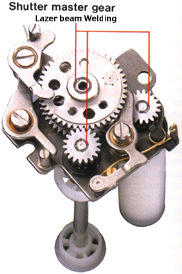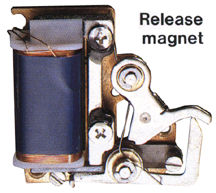Shutter durability A
camera can have the greatest shutter speed accuracy in the world, yet if that accuracy
is lost over time or worse, if the shutter breaks down, the camera will be of little
use to a photographer. Moreover, a professional's camera is often used in conditions
that are far from ideal. All the more reason why the professional needs a reliable
shutter. The New F-1's shutter was not only designed to work under normal climatic
conditions, but also can operates accurately and reliably at temperatures as low
as - 30°C ( - 22°F), as high as +60°C (+ 1 40°F), and at humidity
levels up to 95%.
To ensure that the New F-1's shutter could withstand the stresses imposed by a 5
fps motor drive, Canon tested the shutter for durability over 100,000 Exposure
Cycles. What
goes into making a camera shutter this reliable? Basically, sound design techniques,
critical selection of materials, and quality control in the production process. The
New F-1 shutter was perfected through the application of several new scientific and
engineering developments. The lubricant used to assure smooth performance of the
gear train is but one notable example of these new developments. Since traditional
petroleum-based lubricants are sensitive to high temperatures and humidity, shutter
accuracy often suffers. The Astro-oil
lubricant used in the
New F-1 shutter, however, was developed originally for the NASA space program; it
maintains the same viscosity at all temperatures, and does not decompose under high
humidity levels.
 |
New techniques in precision machining are also used in the New F-1's shutter. The bearing contact surfaces of all shafts are polished to a mirror-smooth finish, and the bearing inserts in the die-cast body have been ball-burnished. Moreover, where parts welding is required, laser-beam welding is used. Finally, heavier metal parts have been replaced by low friction coefficient plastic where feasible, which reduces camera weight. |
Hybrid shutter mechanical control The mechanical control system is very similar to that used in the former F-1: the speed adjustment mechanism is located on the upper portion of the shutter shaft and is coupled to the speed adjustment cam and first curtain shaft. The New F-1's mechanical shutter speeds include a high range from 1/125 sec. to 1/2000 sec. Canon chose not tp include slower shutter speeds because they are not accurate when mechanically operated. The sync speed (1/90 sec.) is also mechanically controlled, and to save battery power, "B" (bulb) is mechanical.
Hybrid shutter electronic control
 |
Electronic shutter speed control times the release of the second curtain. This control mechanism consists basically of a release magnet located on the shutter speed dial shaft at the bottom of the camera. The release magnet must be both powerful and have the proper hysteresis characteristics. The magnet used in the New F-1 is substantially larger than those used in conventional cameras,,and features a wide-area, mirror-smooth contact surface. |
Its strength assures both reliability and great shutter speed accuracy. In two of the modes, manual and shutter priority, the shutter is controlled electronically at speeds ranging from 8 sec. to 1/60 sec. On the other hand, when the AE Finder FN is used for aperture-priority AE operations, time control is entirely electronic, with stepless speeds from 8 sec. to 1/1000 sec. With focal plane shutters, the film is exposed through the opening created between the first and second curtain as the shutter is released. The degree of exposure accuracy will therefore depend in great part on how precisely the width of this opening can be controlled. This is particularly true at the faster shutter speeds, for at 1/2000 sec., the opening is extremely narrow. Any error here will be magnified greatly in the final exposure. In order to obtain this higher accuracy at faster speeds in the New F- 1, the speed of curtain travel has been increased dramatically. Travel time for the New F-1 is a mere 7.5ms, as opposed to 12.5ms in the former F-1. This increase in speed has effectively widened the curtain opening.
Methods used to increase curtain speed It is perhaps easiest to increase curtain speed by using a stronger spring to provide the motive force. This technique, however, has one drawback. A stronger spring would place a greater strain on the film advance mechanism; in the end, more torque would be required to cock the shutter. Canon circumvented this problem by mounting all shafts within the system on precision ball-bearings. And for less resistance, closer machining tolerances in the gear train were obtained. A one-way disc brake has also been developed to stop the faster moving shutter smoothly. The special materials used in the construction of this brake were subjected to exhaustive testing in order to assure reliability over years of use.
 |
 |
 |
| Back | 2/2
Instruction
Manual:
Canon New F-1 Camera | Motor Drive FN | Canon High Speed Motor Drive
Camera
|
Main
Reference/Layout Map for body: HTML | PDF (471k)
Specifications: HTML | PDF (58k)
Canon FD & FDn Lenses.
| Message Board |
for your New Canon F-1 SLR camera(s)
| Message
Board
| for your MF Canon
FD Optics in a shared environment
| Message
Board
| Specifically for Dispose or Looking for Canon/FD Photographic
Equipment
| Back to Main Index Page | Canon New F-1 Website
Its
Concept, Its System
Metering Options,
Viewfinders, Exposures
Control, Reliability
Issues,
Shutter Mechanism; Motor Drives/Winder, Data Film
backs,
Flash photography, Focusing Screens, Macro/Close-up,
Remote photography.
About this photographic site.
Home - Photography in Malaysia |
Copyright © 2000. leofoo ®. MIR Web Development Team.
Credit: Mr Richard Yeow, General Manager of camera and video division, Canon Marketing, Malaysia and Tony Kano, for being so supportive and granting permission to use some of the original content of Canon; Mr Philip Chong for patching some mistakes made earlier in this site. Made with a PowerMac, Broadcating with a RedHat Linux Server.